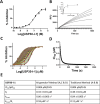Structural Dynamics of the Ubiquitin Specific Protease USP30 in Complex with a Cyanopyrrolidine-Containing Covalent Inhibitor
- PMID: 39804742
- PMCID: PMC11812085
- DOI: 10.1021/acs.jproteome.4c00618
Structural Dynamics of the Ubiquitin Specific Protease USP30 in Complex with a Cyanopyrrolidine-Containing Covalent Inhibitor
Abstract
Inhibition of the mitochondrial deubiquitinating (DUB) enzyme USP30 is neuroprotective and presents therapeutic opportunities for the treatment of idiopathic Parkinson's disease and mitophagy-related disorders. We integrated structural and quantitative proteomics with biochemical assays to decipher the mode of action of covalent USP30 inhibition by a small-molecule containing a cyanopyrrolidine reactive group, USP30-I-1. The inhibitor demonstrated high potency and selectivity for endogenous USP30 in neuroblastoma cells. Enzyme kinetics and hydrogen-deuterium eXchange mass spectrometry indicated that the inhibitor binds tightly to regions surrounding the USP30 catalytic cysteine and positions itself to form a binding pocket along the thumb and palm domains of the protein, thereby interfering its interaction with ubiquitin substrates. A comparison to a noncovalent USP30 inhibitor containing a benzosulfonamide scaffold revealed a slightly different binding mode closer to the active site Cys77, which may provide the molecular basis for improved selectivity toward USP30 against other members of the DUB enzyme family. Our results highlight advantages in developing covalent inhibitors, such as USP30-I-1, for targeting USP30 as treatment of disorders with impaired mitophagy.
Keywords: Hydrogen−Deuterium eXchange-Mass spectrometry; activity-based protein profiling mass spectrometry; cyanopyrrolidine inhibitors; enzyme kinetics; mitophagy; molecular docking; ubiquitin specific protease USP30.
Conflict of interest statement
The authors declare no competing financial interest.
Figures





References
MeSH terms
Substances
LinkOut - more resources
Full Text Sources
Research Materials

